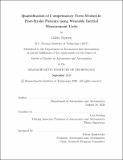Quantification of compensatory torso motion in post-stroke patients using wearable inertial measurement units
Author(s)
Nguyen, Golda(Golda Minh Ý.)
Download1227503908-MIT.pdf (2.570Mb)
Other Contributors
Massachusetts Institute of Technology. Department of Aeronautics and Astronautics.
Advisor
Leia Stirling.
Terms of use
Metadata
Show full item recordAbstract
Occupational Therapy (OT) tasks performed in home or remote environments cannot be observed or assessed by a clinician. For such environments, wearable sensor technologies could provide quantitative assessment of movement strategies to support clinical evaluation via telemedicine. This work presents an algorithm for estimating torso orientation and metrics of compensatory torso motion for upper extremity OT tasks using an Inertial Measurement Unit (IMU) worn on the sternum. Two post-stroke male participants with hemiparesis and two healthy age-matched male participants were evaluated while completing a series of OT evaluations and tasks, including assessments of active range of motion, pinch strength, standing balance, the Moberg pick-up test, Nine-hole peg test, and a custom peg board grasp task. Torso orientation was estimated by decomposing sternum IMU orientation into angles (pitch, roll, yaw) in each anatomical plane (sagittal, coronal, transverse) and referenced against a standing balance posture. Orientation was measured as the participants completed tasks with their unaffected and affected sides (for stroke participants) or dominant and non-dominant sides (for healthy participants). Estimations of sternum IMU orientation were also compared against estimations from a Vicon optical motion capture system, and differences in estimations were not found to be operationally significant. IMU sensitivity to sensor to torso alignment was also evaluated and demonstrated the interaction between pitch and roll estimation. A threshold of nominal torso motion for each participant was created from the variance in torso orientation for tasks where the participant used their dominant or unaffected arm. A metric of percentage of time out of the range of natural variation was defined to assess operationally relevant differences that could inform clinical decision making. These case studies support the use of wearable IMUs to quantitatively assess compensatory torso motions and convey operationally relevant information about movement strategy to a clinician without the use of visual observation.
Description
Thesis: S.M., Massachusetts Institute of Technology, Department of Aeronautics and Astronautics, September, 2020 Cataloged from student-submitted PDF of thesis. Includes bibliographical references (pages 101-105).
Date issued
2020Department
Massachusetts Institute of Technology. Department of Aeronautics and AstronauticsPublisher
Massachusetts Institute of Technology
Keywords
Aeronautics and Astronautics.